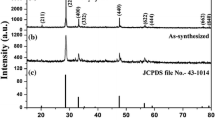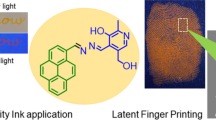Abstract
In this paper, the potential of the Sr4Al14O25: Eu2+,Dy3+ fluorescent nanophosphor is explored to visualize the latent fingermarks. The nanophosphor has been synthesized using self-propagating high temperature synthesis and shows intense luminescence and strong long after glow properties. These nano particles have been characterized for their particle size, crystalline phase, and photoluminescent properties. The calculated PL CIE co-ordinates (0.138, 0.359) correspond to the blue–green shade. Different porous, non-porous, as well as slightly non-smooth surfaces are taken and successfully tested for latent fingerprints development with the prepared Sr4Al14O25: Eu2+,Dy3+ fluorescent nanophosphor powder. Present nano powder is advantageous to use on luminescent or multicolored surfaces as it gives greater contrast and also eliminates the problem of background interferences with the friction ridges due to its strong long after glow property. The results are very good when latent fingerprints were developed on the currency notes with optical variable ink and highly fluorescent pattern areas.













Similar content being viewed by others
References
Lin Y, Tang Z, Zhang Z (2001) Preparation of long-afterglow Sr4Al14O25-based luminescent material and its optical properties. Mater Lett 5:14–18
Lin Y, Tang Z, Zhang Z, Nan CW (2002) Anomalous luminescence in Sr4Al14O25:Eu, Dy phosphors. Appl Phys Lett 81:996–998
Nakazawa E, Murazaki Y, Saito S (2006) Mechanism of the persistent phosphorescence in Sr4Al14O25: Eu and SrAl2O4: Eu codoped with rare earth ions. J Appl Phys 100: 113113(1)–113113(7)
Liu L, Zhang Z, Zhang L, Zhai Y (2009) The effectiveness of strong afterglow phosphor powder in the detection of fingermarks. Forensic Sci Int 183:45–49
Menzel ER, Savoy SM, Ulvick SJ, Chenc KH, Murdock RH, Sudduth MR (2000) Photoluminescent semiconductor nanocrystals for fingerprint detection. J Forensic Sci 45:545–551
Becue A, Champod C, Margot P (2007) Use of gold nanoparticles as molecular intermediates for the detection of fingermarks. Forensic Sci Int 168(2–3):169–176
Menzel ER, Schwierking JR, Menzel LW (2005) Functionalized europium oxide nanoparticles for fingerprint detection: a preliminary study. J Forensic Identification 55(2):189–195
Choi MJ, Mc Donagh AM, Maynard PJ, Wuhrer R, Lennard C, Roux C (2006) Preparation and evaluation of metal nanopowders for the detection of fingermarks on non-porous surfaces. J Forensic Identification 168:756–768
Liu L, Gill SK, Gao YP, Hope-Weeks LJ, Cheng KH (2008) Exploration of the use of novel SiO2 nanocomposites doped with fluorescent Eu3+/ sensitizer complex for latent fingerprint detection. Forensic Sci Int 176(1):163–172
Choi Mi J, Smoother T, Martin AA, McDonagh AM, Maynard PJ, Wuhrer R, Lennard C, Roux C (2007) Fluorescent TiO2 powders prepared using a new perylene diimide dye: Applications in latent fingermark detection. Forensic Sci Int 173(2–3):154–160
Thaker BJ, Hudson KE, Rowell FJ (2008) Doped hydrophobic silica nano- and micro- particles as novel agents for developing latent fingerprints. Forensic Sci Int 174(1):26–34
Choi MJ, McBean KE, Ng Ping HR, McDonagh AM, Maynard PJ, Lennard C, Roux C (2008) An evaluation of nanostructured zinc oxide as a fluorescent powder for fingerprint detection. J Mater Sci 43:732–737. doi:10.1007/s10853-007-2178-5
Wang YF, Yang RQ, Shi ZX, Wang YJ, Liu JJ (2009) Application of CdSe nanoparticle suspension for developing latent fingermarks on the sticky side of adhesives. Forensic Sci Int 185:96–99
Gao F, Han J, Zhang J, Li Q, Sun X, Zheng J, Bao L, Li X, Liu Z (2011) The synthesis of newly modified CdTe quantum dots and their application for improvement of latent fingerprint detection. Nanotechnology 22(7): 075705(1)–075705(9)
Dilag J, Kobus H, Ellis AV (2009) Cadmium sulfide quantum dot/chitosan nanocomposites for latent fingermark detection. Forensic Sci Int 187(1–3):97–102
Bedyal AK, Kumar V, Sharma V, Pitale SS, Coetsee E, Duvenhage MM, Ntwaeaborwa OM, Swart HC (2013) Spectral and surface investigations of Mn2+ doped SrZnO2 nanocrystalline phosphors. J Mater Sci 48:3327–3333. doi:10.1007/s10853-012-7121-8
http://www.mathworks.com/matlabcentral/fileexchange/29620-ciecoordinatecalculator
Cullity BD (1956) Element of X-ray diffraction, 2nd edn. Addison-Wesley, New York
Zhao C, Chen D, Yuan Y, Wu M (2006) Synthesis of Sr4Al14O25:Eu2+, Dy3+ phosphor nanometer powders by combustion processes and its optical properties. Mater Sci Eng B133:200–204
Chang CK, Jiang L, Mao DL, Feng CL (2004) Photoluminescence of 4SrO7Al2O3 ceramics sintered with the aid of B2O3. Ceram Int 30:285–290
Smets B, Rutten J, Hoeks G, Verlijsdonk J (1989) 2SrO·3Al2O3: Eu2+ and 1.29 (Ba, Ca ) O 6Al2O3: Eu2+ two new blue-emitting phosphors. J Electrochem Soc 136(7):2119–2123
Kaiya K, Takahashi N, Nakamura T, Matsuzawa T, Smith GM, Riedi PC (2000) EPR studies of europium(II)-doped strontium aluminate phosphors. J Lumin 87–89:1073–1075
Acknowledgements
The corresponding author is thankful to BRNS, Department of Atomic Energy (DAE), BARC, Mumbai for providing funds for the study in the form of a Young Scientist Research project (DAE sanction no. 2011/20/37P/05/BRNS).
Author information
Authors and Affiliations
Corresponding author
Rights and permissions
About this article
Cite this article
Sharma, V., Das, A., Kumar, V. et al. Potential of Sr4Al14O25: Eu2+,Dy3+ inorganic oxide-based nanophosphor in Latent fingermark detection. J Mater Sci 49, 2225–2234 (2014). https://doi.org/10.1007/s10853-013-7916-2
Received:
Accepted:
Published:
Issue Date:
DOI: https://doi.org/10.1007/s10853-013-7916-2




